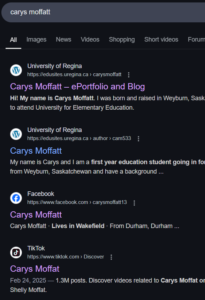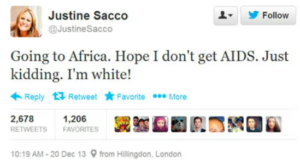Digital identity is a collection of information about a given person online. This can be a collection of their social media, public records, or what other people post about them. We all have a digital identity – meaning anyone who is online, including you as you read this blog. Every identity is different, and effects our interactions, feeds, and level of exposure and activity.
Carys Moffatt – Enter
 When I search my name on the internet, the first few things to pop up are a collection of my online platforms along with someone else with the same name who I will call “Imposter C.” When I enter my name into Google, my blog, followed by Imposter C’s Facebook and TikTok show up. Then my Instagram, Imposter C’s Pinterest, my cheer companies website, my TikTok, etc. My Identity is inter-mingled with Imposter C’s, simply because we share a first and last name. However, our identities are entirely different. We’re both from two different places, live two different lives, and have two different online identities. The only thing we share is our name.
When I search my name on the internet, the first few things to pop up are a collection of my online platforms along with someone else with the same name who I will call “Imposter C.” When I enter my name into Google, my blog, followed by Imposter C’s Facebook and TikTok show up. Then my Instagram, Imposter C’s Pinterest, my cheer companies website, my TikTok, etc. My Identity is inter-mingled with Imposter C’s, simply because we share a first and last name. However, our identities are entirely different. We’re both from two different places, live two different lives, and have two different online identities. The only thing we share is our name.
 Someone’s identity is their name and who they are as a person. Their online identity is who they are online. Comparing my accounts to Imposter C’s.; She posts on Facebook often, I have one post. She has hundreds of TikTok posts, I have five. Her Pinterest boards are full of aesthetic designs for her house, her dream wedding, and clothes, where mine is a collection of memes of any show or movie I’ve had an obsession with.
Someone’s identity is their name and who they are as a person. Their online identity is who they are online. Comparing my accounts to Imposter C’s.; She posts on Facebook often, I have one post. She has hundreds of TikTok posts, I have five. Her Pinterest boards are full of aesthetic designs for her house, her dream wedding, and clothes, where mine is a collection of memes of any show or movie I’ve had an obsession with.
Our digital identities are shown through the platforms we use and the amount of accounts we have on a platform. I have a second account for my TikTok for my Learning Project Posts, she only has her main TikTok account (assuming she doesn’t have a private one under a different name). The picture to the right is Imposter C.
One Account or Five?
Our digital identities consist of our platform’s. Personally, I don’t post much on my accounts, but I like to have them for entertainment and to check up on family and friends. My one friend has multiple accounts on every platform she uses so she can have an account for public, and one for private. Another friend of mine keeps it simple with only one account on his platforms, accept for TikTok, where he has five accounts. In Nicole Lee’s blog, she explains how “having multiple accounts is the norm,” and “having one account is the exception.” According to Lee, having multiple accounts on a platform takes the pressure off of having a perfect feed of social moments, and having one account is confining.
The pressure Lee referred to is seen in many teenagers. Take Madison Holleran for example. She was active on Instagram, where she only had one account. Her account was ‘perfect’ in the eyes of everyone, and they all expressed how she looked so happy online that she must be in real life too. At one point, her mother saw a picture and said she “looked happy,” but Madison firmly replied “It’s just a picture.”
Just a picture indeed. Everyone puts out what they want others to see of themselves on the internet. Madison’s Instagram was edited to make her look happy, but in real life she was depressed, and unfortunately took her life unexpectedly in the eyes of her family. The expectation for people to edit what their lives look like online forces them to try to replicate that in real life, causing depression, cyberbullying, and burn-outs.
Shaming vs Cyberbullying – They’re not That Different
Justine Sacco was made terribly famous overnight all from one Twitter post. She went from a private person to globally shamed, all while being stuck on an airplane, and after landing opening her phone to pure assault on her feed. Jon Ronson’s TEDxTalk covered her online shaming, and he posed a question that almost none of her attackers had considered; Was that what she intended? The answer is no. When asked, Justine stated that “living in America puts us in a bit of a bubble. When it comes to what is going on in the Third World, I was making fun of that bubble.” What Justine meant to be a clever dig at the lack of knowledge in America, was what Jon described as “mistaken racism,” due to society wanting nothing but to blame someone because they can, especially since it was all happening online, and Justine could not respond to the internet’s comments.

Justine’s case is an example of how extreme internet usage can be. Whether it’s internet shaming or cyberbullying, it happens everyday. Think about teenagers and children with phones. Without their brains fully developed, they make reckless decisions without thinking twice about it. Sometimes, what’s meant to be a silly post, can cause someone to be tormented to the point of suicide. In these cases, the person affected is the victim, and because it is an online platform and the rules magically change, the tormenter gets away with their acts most of the time. This standard is corrupt, and in the cases of cyberbullying and Justine’s public shaming, people should be held accountable for their words and acts, and allow people the benefit of doubt where it’s due.
It’s interesting how digital identities can get mixed up, especially when sharing a name. This shows how important it is to be mindful of what we post online. The Madison Holleran example highlights how curated personas can lead to pressure and mental health struggles. If you’re interested, I found a cool lesson plan activity to teach students about digital identity:
https://mediasmarts.ca/teacher-resources/representing-ourselves-online